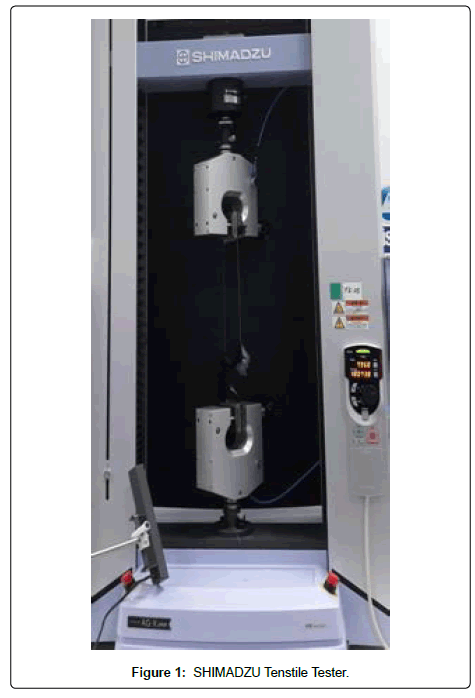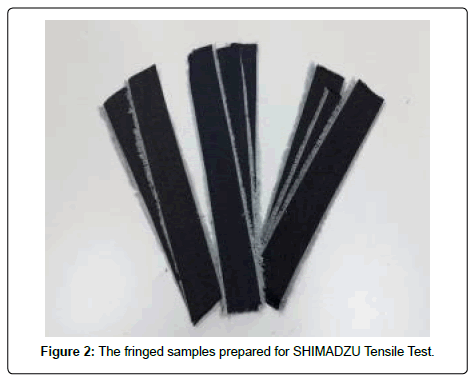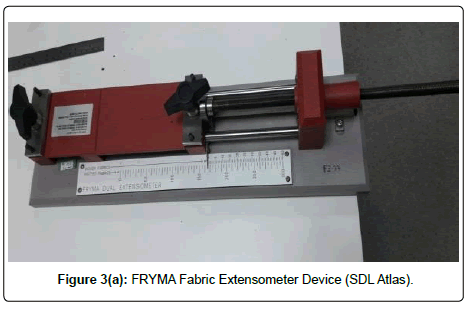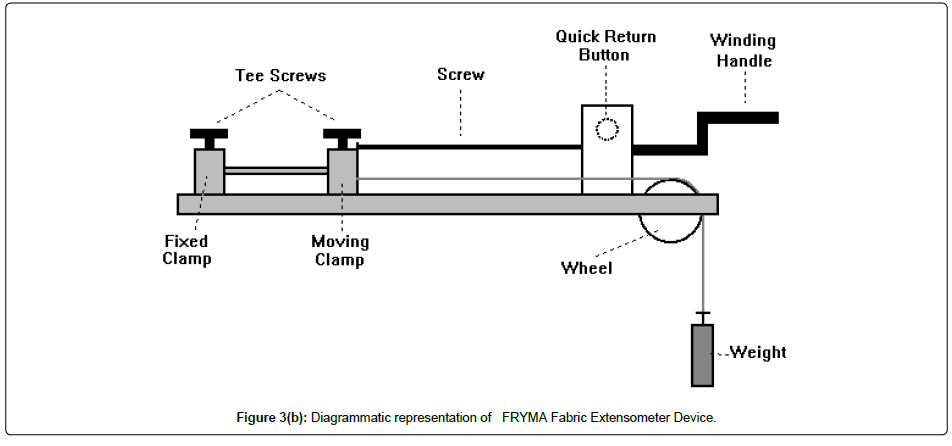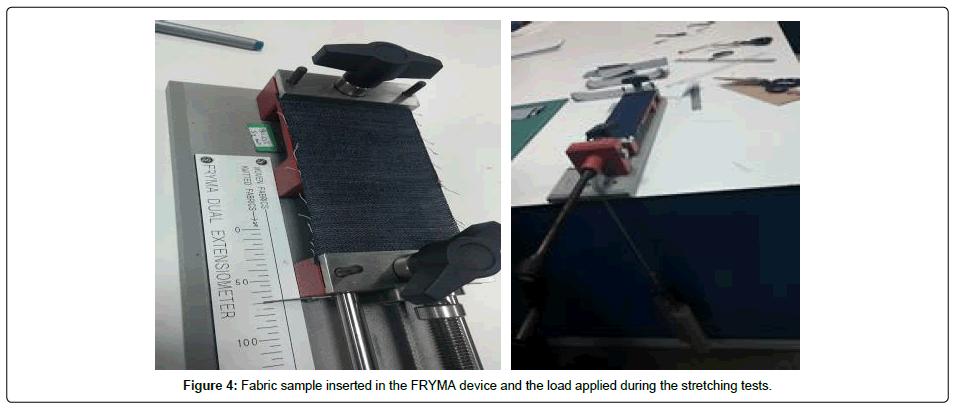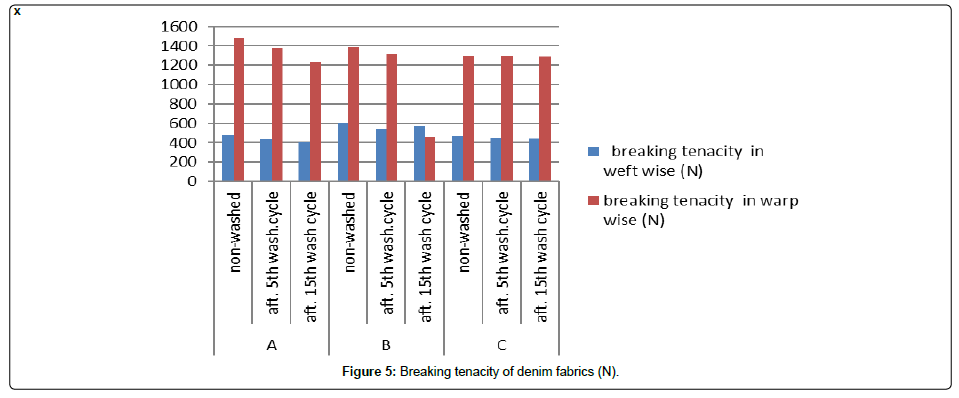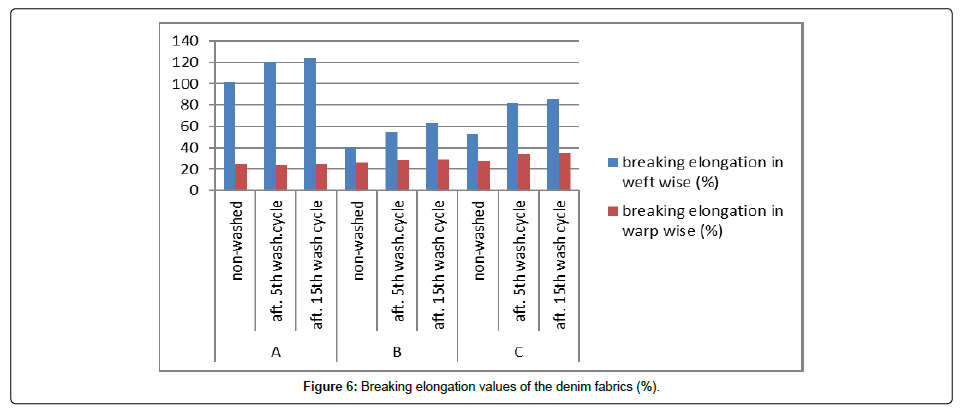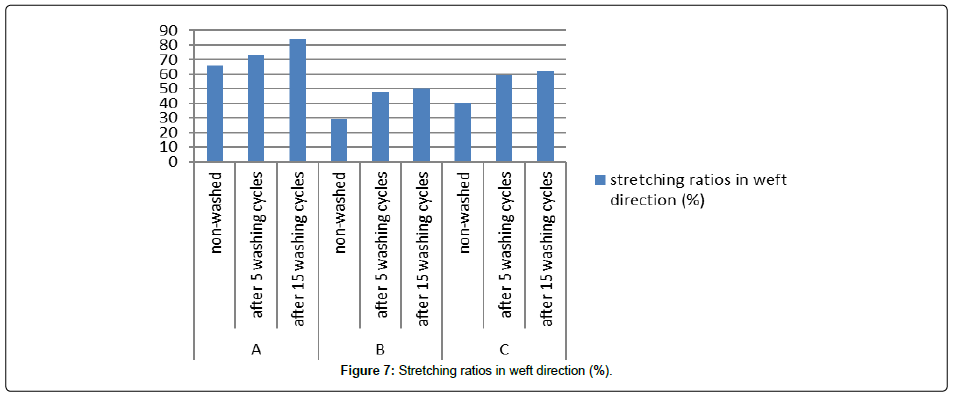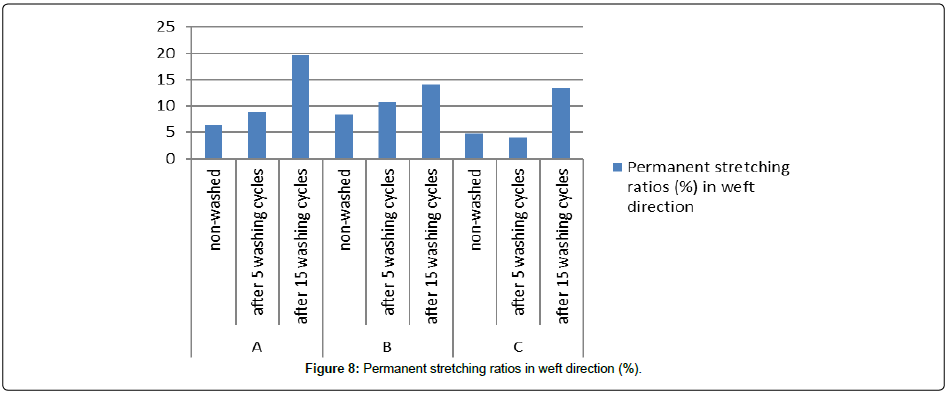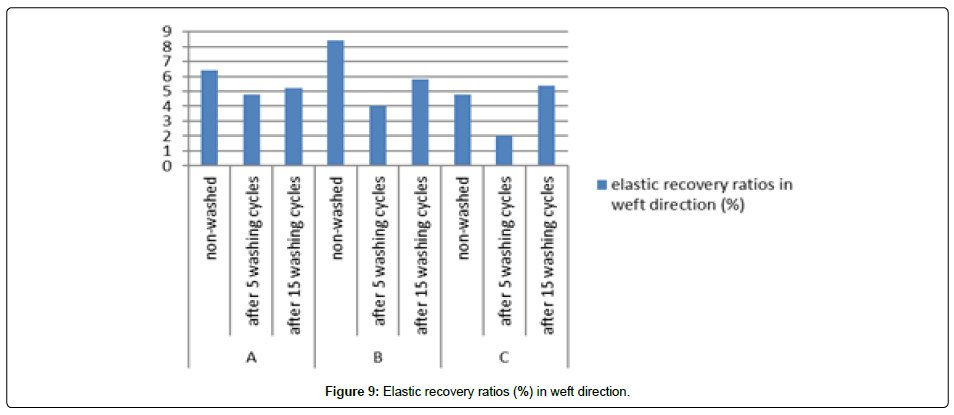Research Article, J Fashion Technol Textile Eng S Vol: 0 Issue: 5
Effect of Washing Cycle on Tenacity and Stretching Properties of Denim Fabrics Containing Elastane
Çeven EK1, Eren HA1, Günaydın GK2*, Sevim Ö1 and Şan C1
1Uludag University, Faculty of Engineering, Textile Engineering Department, Gorukle Campus, 16059, Nilüfer, Bursa, Turkey
2Pamukkale University, Buldan Vocational School, Fashion & Design Programme, Buldan, Denizli, Turkey
*Corresponding Author : Gizem Karakan Günaydin
Lecturer, Uludag University, Faculty of Engineering, Textile Engineering Department, Gorukle Campus, 16059, Nilüfer, Bursa, Turkey
Tel: + +90 258 431 8620 – 133
E-mail: ggunaydin@pau.edu.tr
Received: September 15, 2017 Accepted: September 28, 2018 Published: October 04, 2018
Citation: Çeven EK, Eren HA, Günaydın GK, Sevim Ö, Şan C (2018) Effect of Washing Cycle on Tenacity and Stretching Properties of Denim Fabrics Containing Elastane. J Fashion Technol Textile Eng S5:003. doi:10.4172/2329-9568.S5-003
Abstract
Elastane containing denim fabrics which are known as “blue jeans” have always been popular. Denim fabrics are woven with white elastane-cotton weft yarns and 100% cotton indigo dyed warp yarns. The most distinctive feature of denim fabrics is those warp yarns’ indigo color fading after washing processes which enhance the denim fabrics having unique structures. The elastane amount in the weft yarns determines the flexibility ratio of the denim fabric with its high recovery property. This study aims to investigate the denim fabrics produced at three different weft and warp density with different yarn counts and elastane ratios in terms of tenacity and stretching properties (elongation, permanent elongation, elastic recovery) considering the washing cycles of 0, 5 and 15. Three different denim fabrics with 100% cotton warp yarns and cottonelastane weft yarns were produced at the weft densities of 23,19, 24 (pick/cm) and at the warp densities of 33, 28 and 35 (end/cm) with three different elastane percentages of 4%, 1% and 2.5% respectively. The 2/1 twill denim fabrics were produced on dobby weaving machine. Home laundry process was applied at 30°C for 40 minutes by using 20 ml/kg standard reference detergent containing 5%-15% anionic surface active agents, <0.5% non-anionic surface active agents, soap, enzyme, preservatives and perfumes. Home drying process was applied for 40 minutes after each washing cycle. In order to evaluate the mechanical properties such as breaking tenacity and stretching; the testing devices of Shimadzu and Fyrma fabric extensometer devices were used. As a conclusion tensile and stretching properties of three different denim fabrics varied with the washing cycles.
Keywords: Denim fabrics; Elastane yarn; Stretching property; Tensile property; Washing cycle
Introduction
Elastane containing denim fabrics commonly known as ‘blue jeans’ have always been popular for casual wear. Denim fabric comprises of white elastane-cotton weft yarns and 100% cotton indigo dyed warp yarns. The most distinctive feature of denim fabrics is those warp yarns’ indigo color fading after the washing processes which actually determines the denim fabrics’ unique structures. Denim fabrics’ weft yarns are usually produced with the core spun yarns where there is an elastomeric filament in the core and the staple fibers locating around it. Consequently, the resultant fabric has all the characteristics of the predominant staple fibre together with elastane’s unique stretching and recovery property. Elastane amount in the weft yarns determines the flexibility ratio of the denim fabric with its high recovery property [1-2]. There are some early literatures related to investigation of denim fabrics’ mechanical properties of tenacity, stretching, dimensional stability, abrasion resistance…etc. as well as the influence of some special physical and chemical processes such as sanding, sand spraying, brushing, embroidering, rinsing, stone washing, sand washing, snow washing, stone washing with enzymes, and bleaching [3-6]. Ozdil et al. [3] evaluated the stretch and bagging properties of denim fabrics containing different rates of elastane. After evaluating the mechanical properties such as tensile and tearing strength, bending rigidity, stretching (elongation, maximum elongation, permanent elongation, elastic recovery) and bagging characteristics, they found that increasing the amount of elastane usage in denim fabric offers enhanced comfort properties. Adanur et al. [4] investigated the effect of yarn count, twist multiplier, hairiness, friction coefficient and other yarn properties on denim fabric properties. They found that all these yarn parameters influenced the filling tension hence the denim fabric properties such as fabric weight, thickness, air permeability, dimensional stability, abrasion resistance, drapability, stiffness, wrinkle recovery, tear strength and tensile strength. Ozguney et al. [5] investigated the effects of laser beam on the physical properties of denim fabrics such as tensile strength, tear strength, abrasion resistance and static, kinematic friction coefficients were investigated in order to determine the optimum process conditions. Tarhan et al. [6] analyzed the effect of fading methods such as sand-blasting, laser and washing on performance properties of denim products. They concluded that fading methods decreased tensile strength and weight values and the decrement ratios varied with the intensity and pressure of fading methods. This study aims to contribute to literature by investigating the denim fabrics produced at three different weft and warp density with different yarn counts and elastane ratios in terms of tenacity and stretching properties (elongation, permanent elongation, elastic recovery) considering the washing cycles of 0, 5 and 15.
Materials and Methods
3 different denim fabrics with 100% cotton warp yarns and cotton-elastane weft yarns were produced at the weft densities of 23,19, 24 (pick/cm) and at the warp densities of 33, 28 and 35 (end/cm) with three different elastane percentages of 4%, 1% and 2.5% respectively. The 2/1 twill denim fabrics were produced on dobby weaving machine. Home laundry process was applied at 30 for 40 minutes by using the 20 ml/kg standard reference detergent containing 5%-15% anionic surface active agents, <0.5% non-anionic surface active agents, soap, enzyme, preservatives and perfumes. Home drying process was applied for 40 minutes after each washing cycle. All fabric samples were conditioned for 24 hours in standard atmospheric conditions (at a temperature of 20 ± 2 °C and relative humidity of 65 ± 2%). Table 1 displays the experimental design of the study.
| Fabric Code | Warp Yarn Count (Ne) | Weft Yarn Count (Ne) |
Warp Density (warp/cm) | Weft Density (weft/cm) | Elastane Percentage (%)in denim fabrics |
|---|---|---|---|---|---|
| A | 14 -18 | 18 | 33 | 23 | 4 |
| B | 10 | 12 | 28 | 19 | 1 |
| C | 14 | 18 | 35 | 24 | 2.5 |
Table 1: Experimental design.
In order to evaluate the mechanical properties of breaking tenacity and stretching; the testing devices of Shimadzu and Fyrma fabric extensometer devices were used respectively. Both for tensile and stretching tests were evaluated for the non-washed denim fabrics, for the denim fabrics applied to 5 washing cycles and for the denim fabrics applied to 15 washing cycles. By using Shimadzu device; breaking tenacity and breaking elongation (%) values of denim fabrics in weft and warp wise were obtained following the standard of EN ISO 13934-1 (Figure 1). Test parameters were adjusted as 200 mm gauge length, 200 cN pretension and 100 mm/min test speed for all fabric samples. The samples were fringed for 0.5 cm from the sides before the test is conducted (Figure 2).
Fyrma fabric extensometer is a stretch testing instrument for determining the stretching ratio (%), permanent stretching ratio (%) and elastic recovery properties according to test standard of BS 14704-1 (Figure 3(a) and 3(b)). The fabric specimens of 75 × 85 mm were prepared and placed so that weft yarns of the fabrics were in the longitudinal direction. It is worth to emphasize that the fabric specimens should be cut with considering the fringing area which does not let any yarn separating from the fabric during the test.
Stretching ratio (%) was obtained as the ratio of extension of the test specimen to its initial length expressed as a percentage after 10 seconds. For the permanent stretching calculation; the specimens were marked 5 cm inside the short edge of the fabric and a 6 kg of load was applied for 2 hours (Figure 4). At the end of 2 hours, the fabrics were exposed to relaxation for one minute and the permanent stretching was calculated. For the woven fabrics, the permanent stretching percentage shouldn’t be more than 3%; otherwise bagging may occur in some parts of the clothes even during normal wearing conditions [3]. The fabrics exposed to permanent stretching test were released for 30 minutes and the shortening distance of marked points were calculated to obtain the elastic recovery ratios (%).
Results and Discussion
Considering the tensile results, it has been found that there was a decrement trend in breaking tenacity value (N) of denim fabric “A” as the washing cycle increased in weft and warp wise (Figure 5). Regarding the denim fabric of “B”; a decrement trend was observed in warp wise as the washing cycle increased however there was not a general trend for the breaking tenacity values in weft wise regarding to washing cycles. When considering the denim fabric groups of C, there was not any prominent change in the breaking tenacity values (N) in warp wise regarding to washing treatments but a decrement trend was found in breaking tenacity values (N) in weft wise as the washing cycle increased. When considering the breaking elongation values (%); there was an increment trend for all denim fabrics’ (A, B, C) breaking elongation value (%) in weft wise as the washing cycle increased (Figure 6). There was also an increment trend of breaking elongation values (%) of denim fabric groups of B, C as the washing cycle increased however breaking elongation values (%) of fabric groups of A exhibited some fluctuation according to washing cycles in warp wise.
The stretching ratios (%) of denim fabric groups of A, B and C increase as the washing cycle increased. The minimum stretching ratios (%) were observed on non-washed denim fabrics whereas the maximum stretching ratios (%) were found on denim fabrics treated with 15 washing cycles (Figure 7). Similar results were observed for the permanent stretching ratios (%) as well (Figure 8). The elastic recovery ratios (%) of A, B, C denim fabric groups exhibited some fluctuation regarding to washing cycles (Figure 9). For the denim fabric groups of A and B, highest elastic recovery ratios (%) were observed on the non-washed denim fabrics however there was a sharp decrease of recovery ratios (%) for the 5 cycle washed fabric groups of A, B and C. An increment was observed again as the washing cycle increased to 15 where the results were slightly lower when compared with the non-washed denim fabrics’ elastic recovery ratios (%).
Conclusion
It has been found that three different denim fabrics with 100% cotton warp yarns and cotton-elastane weft yarns produced at different warp and weft densities with three different elastane percentages of 4%, 1% and 2.5% generally revealed an increasing trend in terms of breaking tenacity as the washing cycle increased where they generally revealed a decreasing trend in terms of breaking elongation values (%) regarding to washing cycle. Considering the stretching properties, higher values for stretching ratios (%) and permanent stretching ratios (%) of denim samples were obtained as the washing cycle increased whereas there was a fluctuation observed for the elastic recovery ratios (%) regarding to washing cycles. This study is thought to be useful for the new studies concerning the influence of washing cycles on denim fabrics’ mechanical properties.
References
- Bajaj P and Agarwal R (1999) Innovations in denim production. Amencan Dyestuff Reptr 88: 26-38.
- Radetić M., JovanÄÂić P, PuaÄ N, Petrović ZL, Šaponjić Z (2009) Plasma-induced decolorization of indigo-dyed denim fabrics related to mechanical properties and fiber surface morphology. Text Res J 79: 558-565.
- Özdil N (2008) Stretch and bagging properties of denim fabrics containing different rates of elastane. Fibres Text East Eur 66: 63-67.
- Adanur S, Qi J (2008) Property analysis of denim fabrics made on air-jet weaving machine part II: Effects of tension on fabric properties. Text Res J 78: 10-20.
- Özgüney AT, Özçelik G. Özkaya K (2009) A study on specifying the effect of laser fading process on the color and mechanical properties of the denim fabrics. Tekstil ve Konfeksiyon 19: 133-138.
- Tarhan M, Sarıisik M (2009) A comparison among performance characteristics of various denim fading processes. Text Res J 79: 301-309.
 Spanish
Spanish  Chinese
Chinese  Russian
Russian  German
German  French
French  Japanese
Japanese  Portuguese
Portuguese  Hindi
Hindi 